Interaction between SARS-CoV PBM and Cellular PDZ Domains Leading to Virus Virulence
Abstract
:1. Introduction
2. Materials and Methods
2.1. Ethics Statement
2.2. Cells
2.3. Generation of Recombinant Virus Infectious Clones
2.4. Recovery of Recombinant Virus Variants from cDNA Clones
2.5. Growth Kinetics
2.6. Mice
2.7. Lung Viral Titers of Infected Mice
2.8. RNA Analysis
2.9. Binding of SARS-CoV E Protein to Syntenin-1
2.10. Statistical Analysis
3. Results
3.1. Role of the PBM Sequence of 3a and E Proteins in the Viability and Virulence of SARS-CoV
3.2. Extension of SARS-CoV E Protein PBM
3.3. Relevance of Alternative E Protein Residues in the PBM or in the Proximal Flanking N-Terminus of the PBM Core Motif, in SARS-CoV Pathogenesis
3.4. Interaction between the PBM of SARS-CoV E Protein and the PDZ Domain of Syntenin-1
4. Discussion
4.1. Relevance of 3a and E Protein PBM Sequences in SARS-CoV Replication and Virulence
4.2. Extension of the PBM of SARS-CoV E Protein
4.3. Interaction between the PBM of SARS-CoV E Protein and the PDZ Domain of Human Syntenin-1
Author Contributions
Funding
Institutional Review Board Statement
Informed Consent Statement
Data Availability Statement
Acknowledgments
Conflicts of Interest
References
- Gorbalenya, A.E.; Baker, S.C.; Baric, R.S.; de Groot, R.J.; Drosten, C.; Gulyaeva, A.A.; Haagmans, B.I.; Lauber, C.; Leontovich, A.M.; Neuman, B.W.; et al. The species Severe acute respiratory syndrome-related coronavirus: Classifying 2019-nCoV and naming it SARS-CoV-2. Nat. Microbiol. 2020, 5, 536–544. [Google Scholar]
- Drosten, C.; Gunther, S.; Preiser, W.; van der Werf, S.; Brodt, H.R.; Becker, S.; Rabenau, H.; Panning, M.; Kolesnikova, L.; Fouchier, R.A.; et al. Identification of a novel coronavirus in patients with severe acute respiratory syndrome. N. Engl. J. Med. 2003, 348, 1967–1976. [Google Scholar] [CrossRef] [PubMed]
- Rota, P.A.; Oberste, M.S.; Monroe, S.S.; Nix, W.A.; Campganoli, R.; Icenogle, J.P.; Peñaranda, S.; Bankamp, B.; Maher, K.; Chen, M.-H.; et al. Characterization of a novel coronavirus associated with severe acute respiratory syndrome. Science 2003, 300, 1394–1399. [Google Scholar] [CrossRef] [PubMed]
- Kennedy, M.B. Origin of PDZ (DHR, GLGF) domains. Trends Biochem. Sci. 1995, 20, 350. [Google Scholar] [CrossRef]
- Castaño-Rodriguez, C.; Honrubia, J.M.; Gutiérrez-Álvarez, J.; Sola, I.; Enjuanes, L. Viral PDZ Binding Motifs Influence Cell Behavior Through the Interaction with Cellular Proteins Containing PDZ Domains. Methods Mol. Biol. 2021, 2256, 217–236. [Google Scholar] [PubMed]
- Castaño-Rodriguez, C.; Honrubia, J.M.; Gutierrez-Alvarez, J.; DeDiego, M.L.; Nieto-Torres, J.L.; Jimenez-Guardeño, J.M.; Regla-Nava, J.A.; Fernandez-Delgado, R.; Verdia-Baguena, C.; Queralt-Martin, M.; et al. Role of severe acute respiratory syndrome coronavirus viroporins E, 3a, and 8a in replication and pathogenesis. mBio 2018, 9, e2325-17. [Google Scholar] [CrossRef] [PubMed]
- Jimenez-Guardeño, J.M.; Nieto-Torres, J.L.; DeDiego, M.L.; Regla-Nava, J.A.; Fernandez-Delgado, R.; Castaño-Rodriguez, C.; Enjuanes, L. The PDZ-binding motif of severe acute respiratory syndrome coronavirus envelope protein Is a determinant of viral pathogenesis. PLoS Pathog. 2014, 10, e1004320. [Google Scholar] [CrossRef] [PubMed]
- DeDiego, M.L.; Nieto-Torres, J.L.; Regla-Nava, J.A.; Jimenez-Guardeño, J.M.; Fernandez-Delgado, R.; Fett, C.; Castaño-Rodriguez, C.; Perlman, S.; Enjuanes, L. Inhibition of NF-kappaB mediated inflammation in severe acute respiratory syndome coronavirus-infected mice increases survival. J. Virol. 2014, 88, 913–924. [Google Scholar] [CrossRef] [PubMed]
- DeDiego, M.L.; Nieto-Torres, J.L.; Jimenez-Guardeño, J.M.; Regla-Nava, J.A.; Castaño-Rodriguez, C.; Fernandez-Delgado, R.; Usera, F.; Enjuanes, L. Coronavirus virulence genes with main focus on SARS-CoV envelope gene. Virus Res. 2014, 194, 124–137. [Google Scholar] [CrossRef] [PubMed]
- Fett, C.; DeDiego, M.L.; Regla-Nava, J.A.; Enjuanes, L.; Perlman, S. Complete protection against severe acute respiratory syndrome coronavirus-mediated lethal respiratory disease in aged mice by immunization with a mouse-adapted virus lacking E protein. J. Virol. 2013, 87, 6551–6559. [Google Scholar] [CrossRef] [PubMed]
- Almazan, F.; Sola, I.; Zuñiga, S.; Marquez-Jurado, S.; Morales, L.; Becares, M.; Enjuanes, L. Coronavirus reverse genetic systems: Infectious clones and replicons. Virus Res. 2014, 189, 262–270. [Google Scholar] [CrossRef] [PubMed]
- UniProt Consortium. UniProt: A hub for protein information. Nucleic Acids Res. 2015, 43, D204–D212. [Google Scholar] [CrossRef] [PubMed]
- Lee, H.; Heo, L.; Lee, M.S.; Seok, C. GalaxyPepDock: A protein-peptide docking tool based on interaction similarity and energy optimization. Nucleic Acids Res. 2015, 43, W431–W435. [Google Scholar] [CrossRef] [PubMed]
- Abraham, M.J.; Murtola, T.; Schulz, R.; Páll, S.; Smith, J.C.; Hess, B.; Lindahl, E. GROMACS: High performance molecular simulations through multi-level parallelism from laptops to supercomputers. SoftwareX 2015, 1–2, 19–25. [Google Scholar] [CrossRef]
- Kaminski, G.A.; Friesner, R.A.; Tirado-Rives, J.; Jorgensen, W.L. Evaluation and Reparametrization of the OPLS-AA Force Field for Proteins via Comparison with Accurate Quantum Chemical Calculations on Peptides. J. Phys. Chem. B 2001, 105, 6474–6487. [Google Scholar] [CrossRef]
- Wang, R.; Lu, Y.; Wang, S. Comparative evaluation of 11 scoring functions for molecular docking. J. Med. Chem. 2003, 46, 2287–2303. [Google Scholar] [CrossRef] [PubMed]
- Neudert, G.; Klebe, G. DSX: A knowledge-based scoring function for the assessment of protein-ligand complexes. J. Chem. Inf. Model. 2011, 51, 2731–2745. [Google Scholar] [CrossRef] [PubMed]
- Trott, O.; Olson, A.J. AutoDock Vina: Improving the speed and accuracy of docking with a new scoring function, efficient optimization, and multithreading. J. Comput. Chem. 2010, 31, 455–461. [Google Scholar] [CrossRef] [PubMed]
- Hassan, M.; Mogollon, D.C.; Fuentes, O.; Sirimulla, S. DLSCORE: A Deep Learning Model for Predicting Protein-Ligand Binding Affinities. ChemRxiv 2018. [Google Scholar] [CrossRef]
- Durrant, J.D.; McCammon, J.A. NNScore 2.0: A neural-network receptor-ligand scoring function. J. Chem. Inf. Model. 2011, 51, 2897–2903. [Google Scholar] [CrossRef] [PubMed]
- Kang, B.S.; Cooper, D.R.; Jelen, F.; Devedjiev, Y.; Derewenda, U.; Dauter, Z.; Otlewski, J.; Derewenda, Z.S. PDZ tandem of human syntenin: Crystal structure and functional properties. Structure 2003, 11, 459–468. [Google Scholar] [CrossRef] [PubMed]
- Theobald, D.L.; Wuttke, D.S. THESEUS: Maximum likelihood superpositioning and analysis of macromolecular structures. Bioinformatics 2006, 22, 2171–2172. [Google Scholar] [CrossRef] [PubMed]
- Lee, H.J.; Zheng, J.J. PDZ domains and their binding partners: Structure, specificity, and modification. Cell Commun. Signal. 2010, 8, 8. [Google Scholar] [CrossRef] [PubMed]
- Bladt, F.; Tafuri, A.; Gelkop, S.; Langille, L.; Pawson, T. Epidermolysis bullosa and embryonic lethality in mice lacking the multi-PDZ domain protein GRIP1. Proc. Natl. Acad. Sci. USA 2002, 99, 6816–6821. [Google Scholar] [CrossRef] [PubMed]
- Boeda, B.; El-Amraoui, A.; Bahloul, A.; Goodyear, R.; Daviet, L.; Blanchard, S.; Perfettini, I.; Fath, K.R.; Shorte, S.; Reiners, J.; et al. Myosin VIIa, harmonin and cadherin 23, three Usher I gene products that cooperate to shape the sensory hair cell bundle. EMBO J. 2002, 21, 6689–6699. [Google Scholar] [CrossRef] [PubMed]
- Hildebrand, J.D.; Soriano, P. Shroom, a PDZ domain-containing actin-binding protein, is required for neural tube morphogenesis in mice. Cell 1999, 99, 485–497. [Google Scholar] [CrossRef] [PubMed]
- Subbaiah, V.K.; Kranjec, C.; Thomas, M.; Banks, L. PDZ domains: The building blocks regulating tumorigenesis. Biochem. J. 2011, 439, 195–205. [Google Scholar] [CrossRef] [PubMed]
- Ganti, K.; Broniarczyk, J.; Manoubi, W.; Massimi, P.; Mittal, S.; Pim, D.; Szalmas, A.; Thatte, J.; Thomas, M.; Tomaic, V.; et al. The human papillomavirus E6 PDZ binding motif: From life cycle to malignancy. Viruses 2015, 7, 3530–3551. [Google Scholar] [CrossRef] [PubMed]
- Handa, Y.; Durkin, C.H.; Dodding, M.P.; Way, M. Vaccinia virus F11 promotes viral spread by acting as a PDZ-containing scaffolding protein to bind myosin-9A and inhibit RhoA signaling. Cell Host Microbe 2013, 14, 51–62. [Google Scholar] [CrossRef] [PubMed]
- Giraud, E.; Del Val, C.O.; Caillet-Saguy, C.; Zehrouni, N.; Khou, C.; Caillet, J.; Jacob, Y.; Pardigon, N.; Wolff, N. Role of PDZ-binding motif from West Nile virus NS5 protein on viral replication. Sci. Rep. 2021, 11, 3266. [Google Scholar] [CrossRef] [PubMed]
- Huang, C.; Narayanan, K.; Ito, N.; Peters, C.J.; Makino, S. Severe acute respiratory syndrome coronavirus 3a protein is released in membranous structures from 3a protein-expressing cells and infected cells. J. Virol. 2006, 80, 210–217. [Google Scholar] [CrossRef] [PubMed]
- Nieto-Torres, J.L.; Dediego, M.L.; Alvarez, E.; Jimenez-Guardeño, J.M.; Regla-Nava, J.A.; Llorente, M.; Kremer, L.; Shuo, S.; Enjuanes, L. Subcellular location and topology of severe acute respiratory syndrome coronavirus envelope protein. Virology 2011, 415, 69–82. [Google Scholar] [CrossRef] [PubMed]
- Yuan, X.; Li, J.; Shan, Y.; Yang, Z.; Zhao, Z.; Chen, B.; Yao, Z.; Dong, B.; Wang, S.; Chen, J.; et al. Subcellular localization and membrane association of SARS-CoV 3a protein. Virus Res. 2005, 109, 191–202. [Google Scholar] [CrossRef] [PubMed]
- Zhang, J.; Yan, X.; Shi, C.; Yang, X.; Guo, Y.; Tian, C.; Long, J.; Shen, Y. Structural basis of beta-catenin recognition by Tax-interacting protein-1. J. Mol. Biol. 2008, 384, 255–263. [Google Scholar] [CrossRef] [PubMed]
- Gutierrez-Alvarez, J.; Honrubia, J.M.; Fernandez-Delgado, R.; Wang, L.; Castaño-Rodriguez, C.; Zuñiga, S.; Sola, I.; Enjuanes, L. Genetically engineered live-attenuated Middle East Respiratory Syndrome Coronavirus viruses confer full protection against lethal infection. mBio 2021, 12, e00103-21. [Google Scholar] [CrossRef] [PubMed]
- Durocher, D.; Henckel, J.; Fersht, A.R.; Jackson, S.P. The FHA domain is a modular phosphopeptide recognition motif. Mol. Cell 1999, 4, 387–394. [Google Scholar] [CrossRef] [PubMed]
- Liao, H.; Yuan, C.; Su, M.I.; Yongkiettrakul, S.; Qin, D.; Li, H.; Byeon, I.J.; Pei, D.; Tsai, M.D. Structure of the FHA1 domain of yeast Rad53 and identification of binding sites for both FHA1 and its target protein Rad9. J. Mol. Biol. 2000, 304, 941–951. [Google Scholar] [CrossRef] [PubMed]
- Mahajan, A.; Yuan, C.; Lee, H.; Chen, E.S.; Wu, P.Y.; Tsai, M.D. Structure and function of the phosphothreonine-specific FHA domain. Sci. Signal. 2008, 1, re12. [Google Scholar] [CrossRef] [PubMed]
- Li, J.; Lee, G.I.; Van Doren, S.R.; Walker, J.C. The FHA domain mediates phosphoprotein interactions. J. Cell Sci. 2000, 113 Pt 23, 4143–4149. [Google Scholar] [CrossRef] [PubMed]
- Barthe, P.; Roumestand, C.; Canova, M.J.; Kremer, L.; Hurard, C.; Molle, V.; Cohen-Gonsaud, M. Dynamic and structural characterization of a bacterial FHA protein reveals a new autoinhibition mechanism. Structure 2009, 17, 568–578. [Google Scholar] [CrossRef] [PubMed]
- Hammet, A.; Pike, B.L.; McNees, C.J.; Conlan, L.A.; Tenis, N.; Heierhorst, J. FHA domains as phospho-threonine binding modules in cell signaling. IUBMB Life 2003, 55, 23–27. [Google Scholar] [CrossRef] [PubMed]
- Jungmichel, S.; Clapperton, J.A.; Lloyd, J.; Hari, F.J.; Spycher, C.; Pavic, L.; Li, J.; Haire, L.F.; Bonalli, M.; Larsen, D.H.; et al. The molecular basis of ATM-dependent dimerization of the Mdc1 DNA damage checkpoint mediator. Nucleic Acids Res. 2012, 40, 3913–3928. [Google Scholar] [CrossRef] [PubMed]
- Liu, J.; Luo, S.; Zhao, H.; Liao, J.; Li, J.; Yang, C.; Xu, B.; Stern, D.F.; Xu, X.; Ye, K. Structural mechanism of the phosphorylation-dependent dimerization of the MDC1 forkhead-associated domain. Nucleic Acids Res. 2012, 40, 3898–3912. [Google Scholar] [CrossRef] [PubMed]
- Luo, S.; Xin, X.; Du, L.L.; Ye, K.; Wei, Y. Dimerization Mediated by a Divergent Forkhead-associated Domain Is Essential for the DNA Damage and Spindle Functions of Fission Yeast Mdb1. J. Biol. Chem. 2015, 290, 21054–21066. [Google Scholar] [CrossRef] [PubMed]
- Wu, H.H.; Wu, P.Y.; Huang, K.F.; Kao, Y.Y.; Tsai, M.D. Structural delineation of MDC1-FHA domain binding with CHK2-pThr68. Biochemistry 2012, 51, 575–577. [Google Scholar] [CrossRef] [PubMed]
- Huang, W.C.; Liao, J.H.; Hsiao, T.C.; Wei, T.W.; Maestre-Reyna, M.; Bessho, Y.; Tsai, M.D. Binding and Enhanced Binding between Key Immunity Proteins TRAF6 and TIFA. Chembiochem 2019, 20, 140–146. [Google Scholar] [CrossRef] [PubMed]
- Chaurushiya, M.S.; Lilley, C.E.; Aslanian, A.; Meisenhelder, J.; Scott, D.C.; Landry, S.; Ticau, S.; Boutell, C.; Yates, J.R., 3rd; Schulman, B.A.; et al. Viral E3 ubiquitin ligase-mediated degradation of a cellular E3: Viral mimicry of a cellular phosphorylation mark targets the RNF8 FHA domain. Mol. Cell 2012, 46, 79–90. [Google Scholar] [CrossRef] [PubMed]
- Regla-Nava, J.A.; Nieto-Torres, J.L.; Jimenez-Guardeño, J.M.; Fernandez-Delgado, R.; Fett, C.; Castaño-Rodriguez, C.; Perlman, S.; Enjuanes, L.; DeDiego, M.L. Severe acute respiratory syndrome coronaviruses with mutations in the E protein are attenuated and promising vaccine candidates. J. Virol. 2015, 89, 3870–3887. [Google Scholar] [CrossRef] [PubMed]
- Grootjans, J.J.; Reekmans, G.; Ceulemans, H.; David, G. Syntenin-syndecan binding requires syndecan-synteny and the co-operation of both PDZ domains of syntenin. J. Biol. Chem. 2000, 275, 19933–19941. [Google Scholar] [CrossRef] [PubMed]
- Grembecka, J.; Cierpicki, T.; Devedjiev, Y.; Derewenda, U.; Kang, B.S.; Bushweller, J.H.; Derewenda, Z.S. The binding of the PDZ tandem of syntenin to target proteins. Biochemistry 2006, 45, 3674–3683. [Google Scholar] [CrossRef] [PubMed]
- Chi, C.N.; Bach, A.; Engström, Å.; Strømgaard, K.; Lundström, P.; Ferguson, N.; Jemth, P. Biophysical characterization of the complex between human papillomavirus E6 protein and synapse-associated protein 97. J. Biol. Chem. 2011, 286, 3597–3606. [Google Scholar] [CrossRef] [PubMed]
- Gerek, Z.N.; Ozkan, S.B. Change in allosteric network affects binding affinities of PDZ domains: Analysis through perturbation response scanning. PLoS Comput. Biol. 2011, 7, e1002154. [Google Scholar] [CrossRef] [PubMed]
- Zhang, J.; Sapienza, P.J.; Ke, H.; Chang, A.; Hengel, S.R.; Wang, H.; Phillips, G.N.; Lee, A.L. Crystallographic and nuclear magnetic resonance evaluation of the impact of peptide binding to the second PDZ domain of protein tyrosine phosphatase 1E. Biochemistry 2010, 49, 9280–9291. [Google Scholar] [CrossRef] [PubMed]
- Honrubia, J.M.; Gutierrez-Alvarez, J.; Sanz-Bravo, A.; Gonzalez-Miranda, E.; Munoz-Santos, D.; Castaño-Rodriguez, C.; Wang, L.; Villarejo-Torres, M.; Ripoll-Gomez, J.; Esteban, A.; et al. SARS-CoV-2-Mediated Lung Edema and Replication Are Diminished by Cystic Fibrosis Transmembrane Conductance Regulator Modulators. mBio 2023, 14, e03136-22. [Google Scholar] [CrossRef] [PubMed]
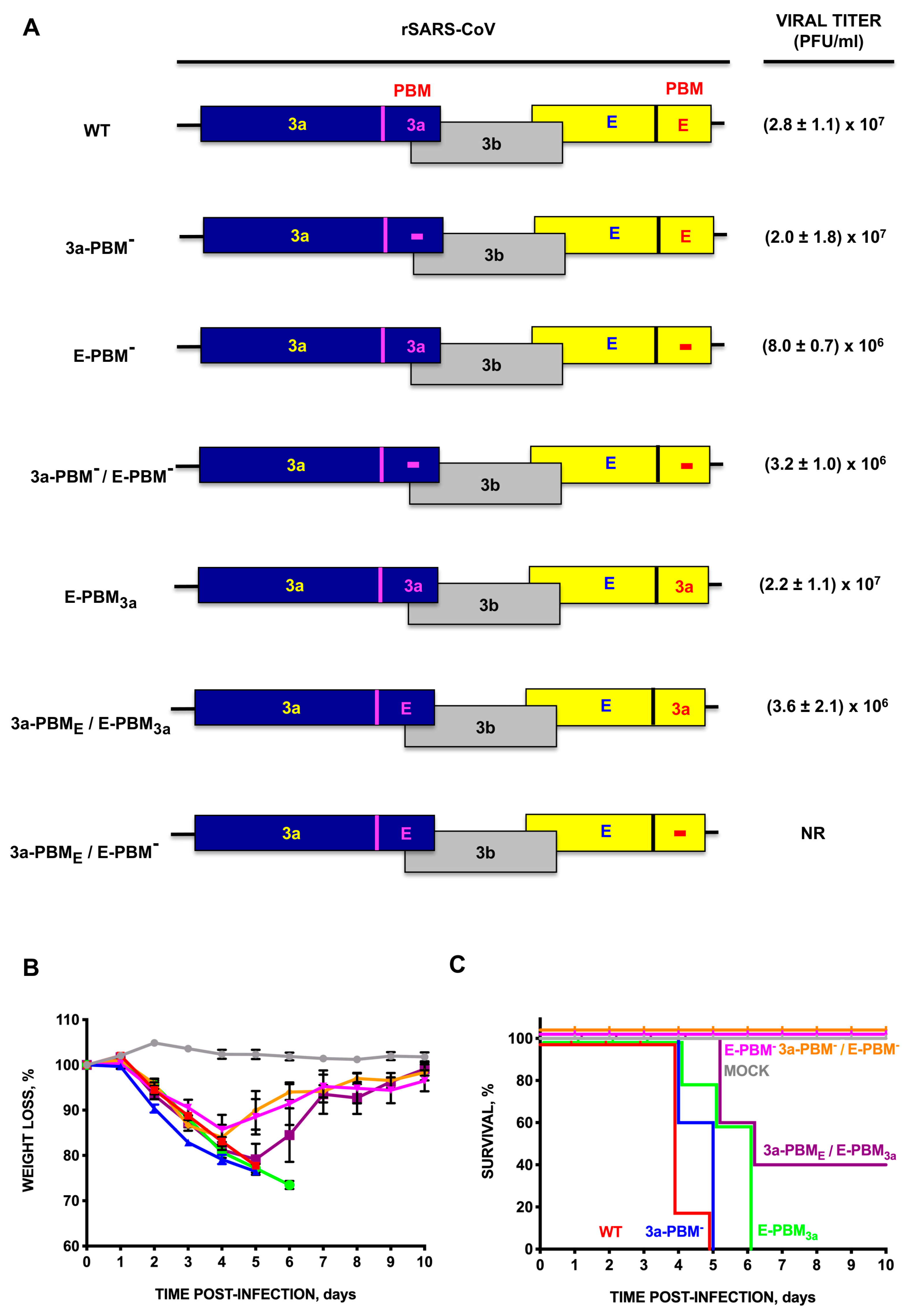
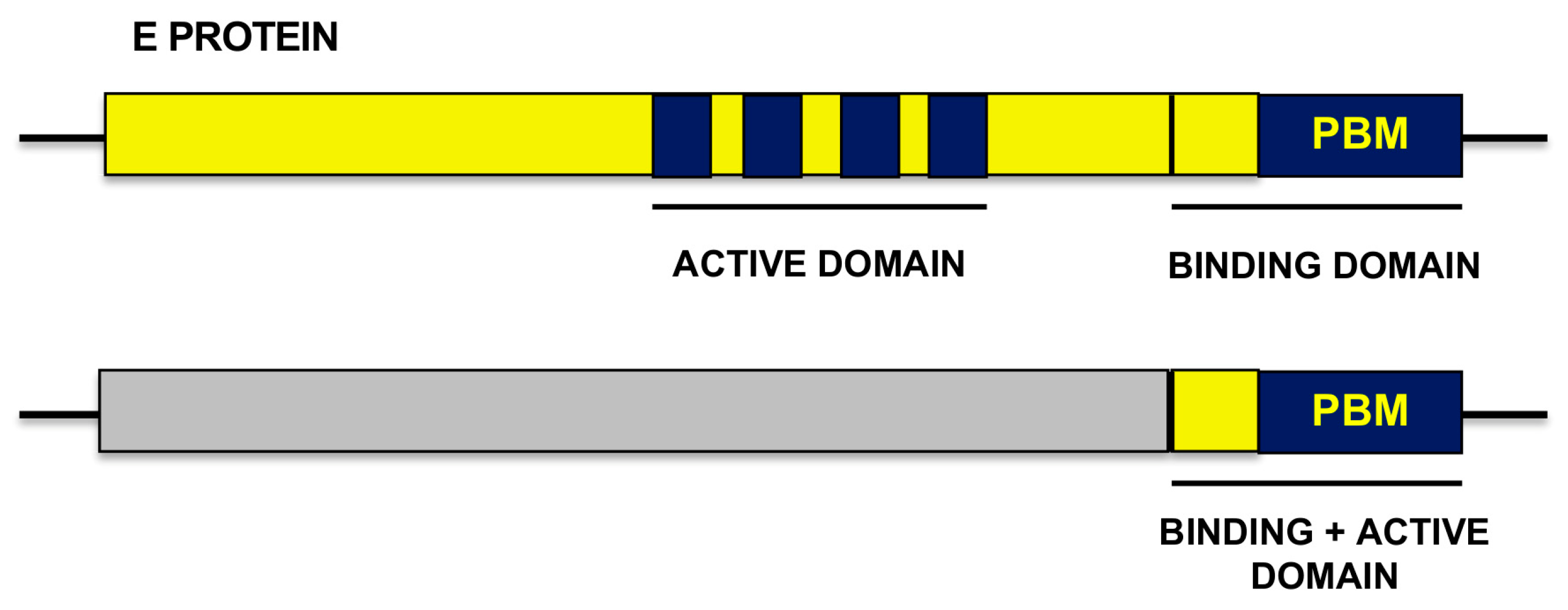
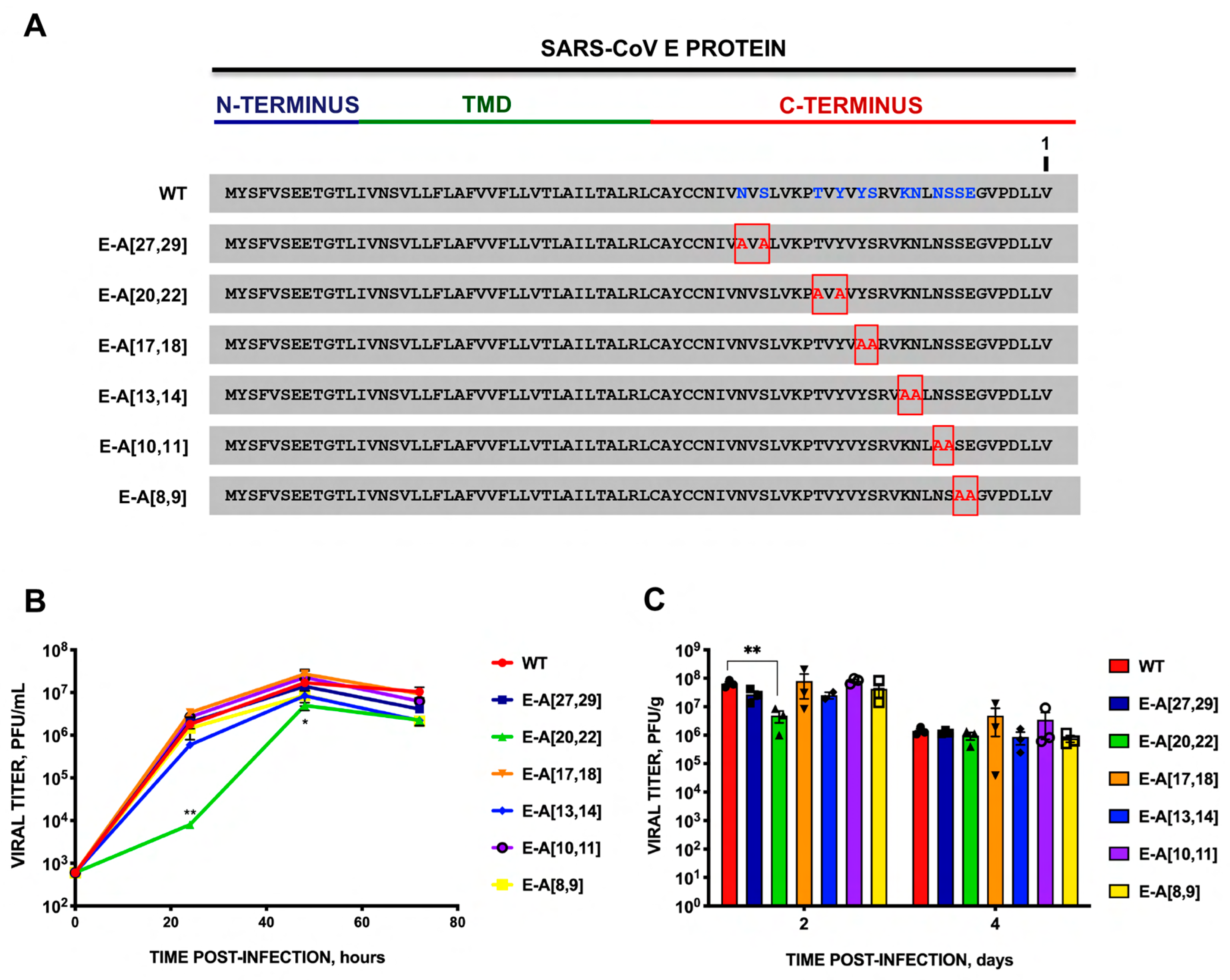
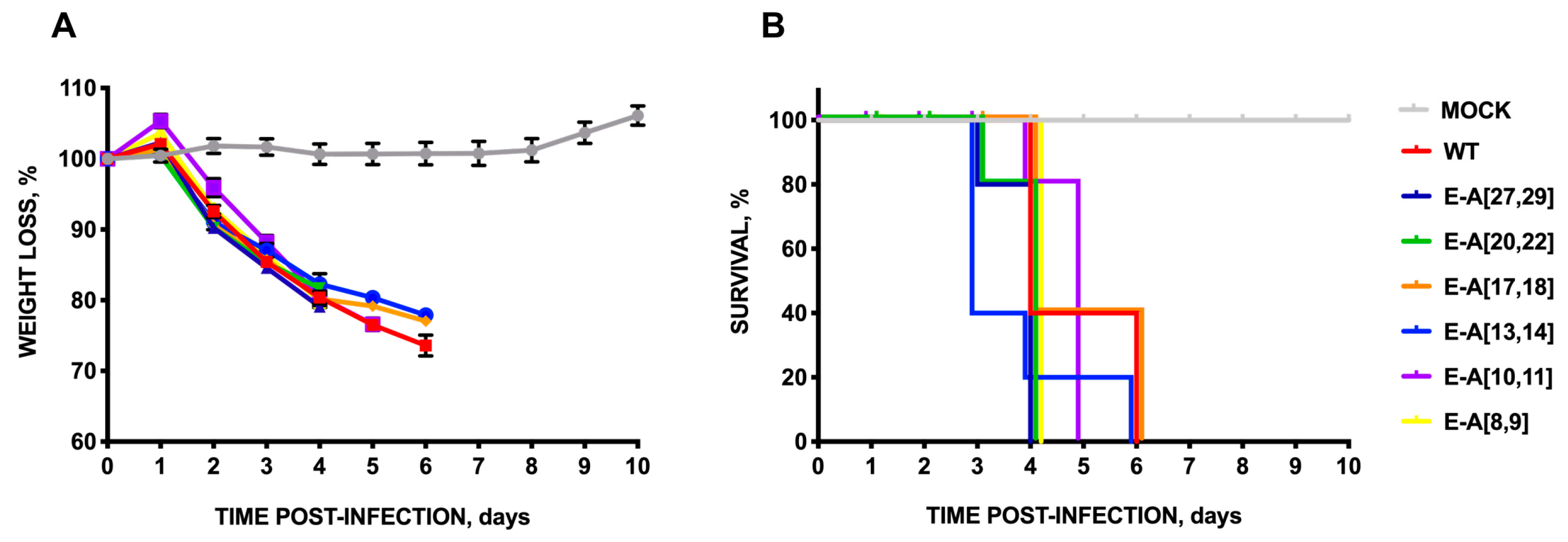
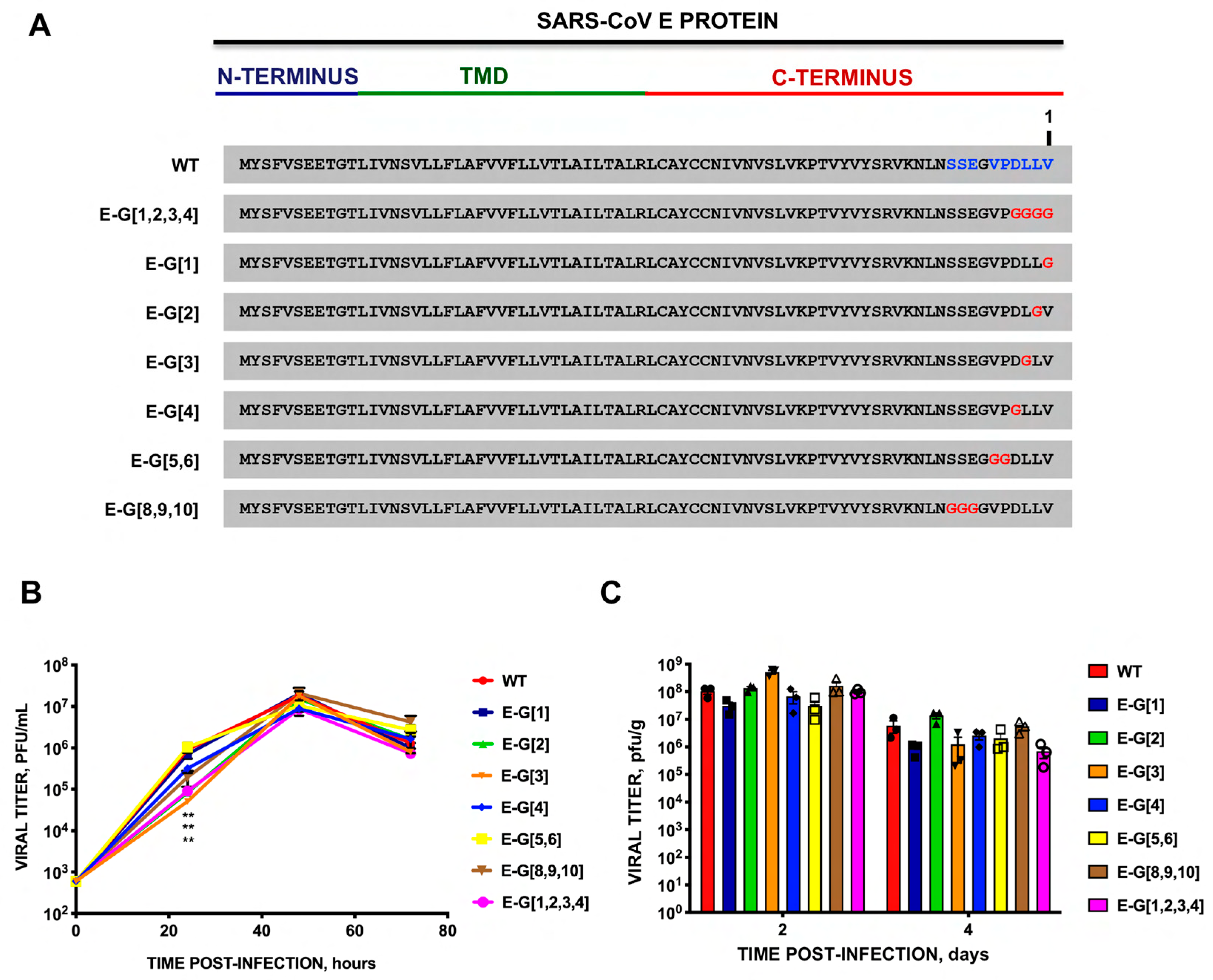


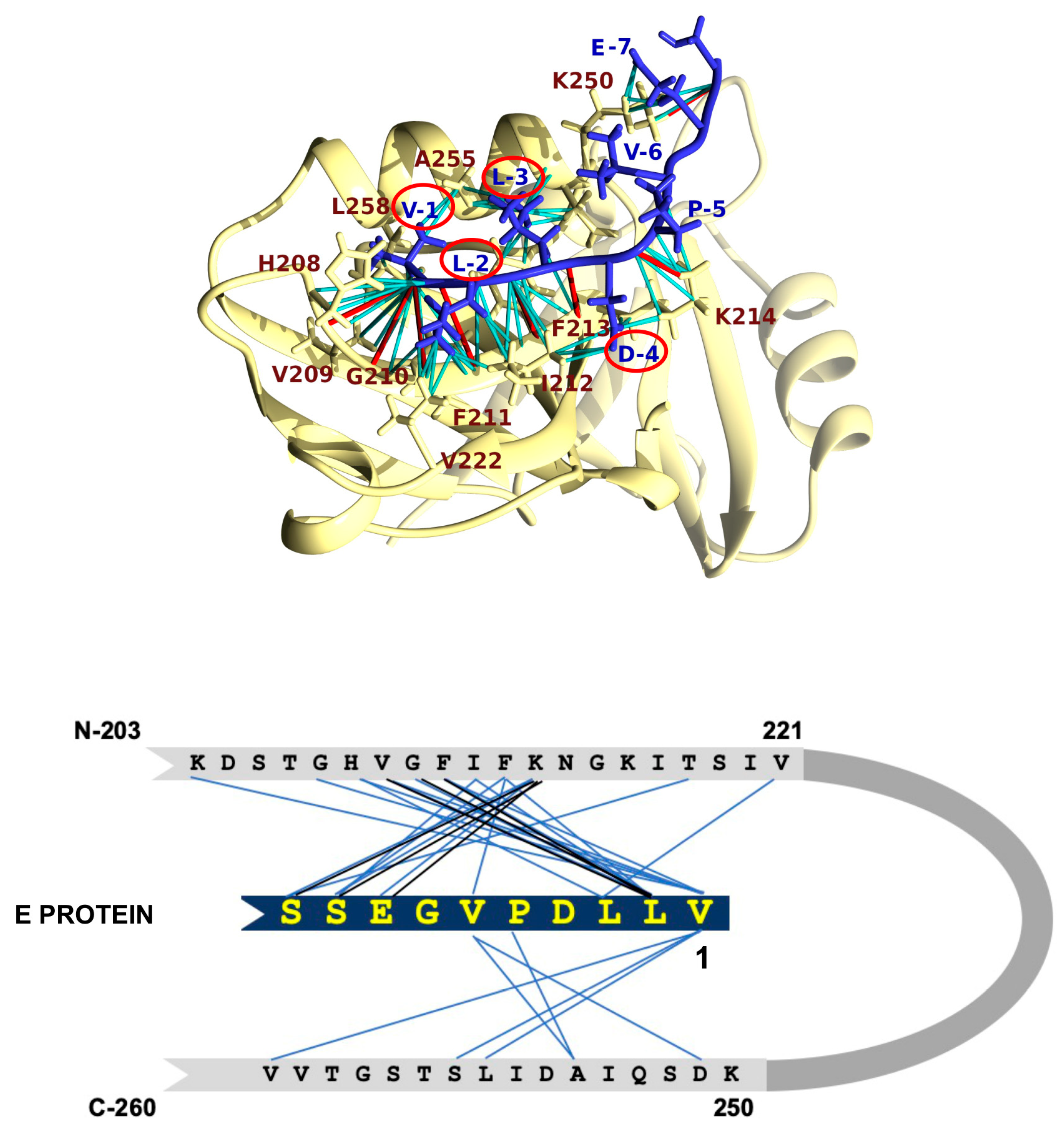
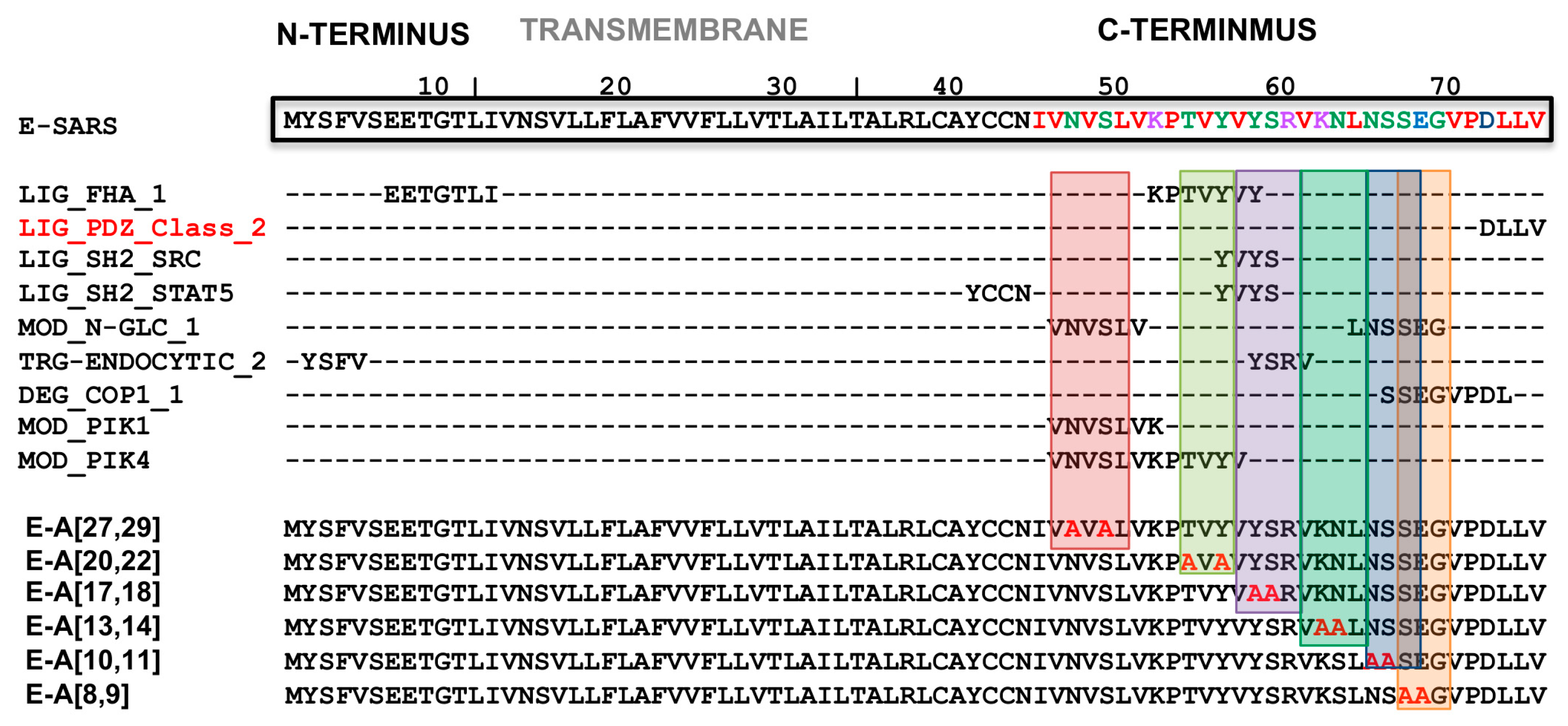
| Virus | Primer | Sequence (5′-3′) 1 |
|---|---|---|
| E-A[27,29] | SARS-E-A[27,29]-RS SARS-E-A[27,29]-VS | CGTTGGTTTTACTAAGGCCACAGCAACAATATTGCAGCA TGCTGCAATATTGTTGCTGTGGCCTTAGTAAAACCAACG |
| E-A[20,22] | SARS-E-A[20,22]-RS SARS-E-A[20,22]-VS | AACACGCGAGTAGACAGCAACGGCTGGTTTTACTAAACT AGTTTAGTAAAACCAGCCGTTGCTGTCTACTCGCGTGTT |
| E-A[17,18] | SARS-E-A[17,18]-RS SARS-E-A[17,18]-VS | CTGATTTTTAACACGGGCGGCGACGTAAACCGTTGG CCAACGGTTTACGTCGCCGCCCGTGTTAAAAATCTG |
| E-A[13,14] | SARS-E-A[13,14]-RS SARS-E-A[13,14]-VS | TTCAGAAGAGTTCAGGGCGGCAACACGCGAGTAGAC GTCTACTCGCGTGTTGCCGCCCTGAACTCTTCTGAA |
| E-A[10,11] | SARS-E-A[10,11]-RS SARS-E-A[10,11]-VS | AGGAACTCCTTCAGAGGCAGCCAGATTTTTAACACG CGTGTTAAAAATCTGGCTGCCTCTGAAGGAGTTCCT |
| E-A[8,9] | SARS-E-A[8,9]-RS SARS-E-A[8,9]-VS | AAGATCAGGAACTCCGGCGGCAGAGTTCAGATTTTT AAAAATCTGAACTCTGCCGCCGGAGTTCCTGATCTT |
| E-G[1] | SARS-E-G[1]-RS SARS-E-G[1]-VS | TAGTTAGTTCGTTTAGCCCAGAAGATCAGGAAC GTTCCTGATCTTCTGGGCTAAACGAACTAACTA |
| E-G[2] | SARS-E-G[2]-RS SARS-E-G[2]-VS | TTAGTTCGTTTAGACCCCAAGATCAGGAACTCC GGAGTTCCTGATCTTGGGGTCTAAACGAACTAA |
| E-G[3] | SARS-E-G[3]-RS SARS-E-G[3]-VS | GTTCGTTTAGACCAGACCATCAGGAACTCCTTC GAAGGAGTTCCTGATGGTCTGGTCTAAACGAAC |
| E-G[4] | SARS-E-G[4]-RS SARS-E-G[4]-VS | CGTTTAGACCAGAAGACCAGGAACTCCTTCAGA TCTGAAGGAGTTCCTGGTCTTCTGGTCTAAACG |
| E-G[5,6] | SARS-E-G[5,6]-RS SARS-E-G[5,6]-VS | TTAGACCAGAAGATCACCACCTCCTTCAGAAGAGTTC GAACTCTTCTGAAGGAGGTGGTGATCTTCTGGTCTAA |
| E-G[8,9,10] | SARS-E-G[8,9,10]-RS SARS-E-G[8,9,10]-VS | AAGATCAGGAACTCCTCCACCACCGTTCAGATTTTTAA TTAAAAATCTGAACGGTGGTGGAGGAGTTCCTGATCTT |
| Length, aa | PBM Hydrogen Bonds | PBM Contacts | Xscore kcal/mol | ||||||||
|---|---|---|---|---|---|---|---|---|---|---|---|
| Val-1 | Leu-2 | Leu-3 | Asp-4 | Total | Val-1 | Leu-2 | Leu-3 | Asp-4 | Total | ||
| 6 | 3 | 0 | 0 | 0 | 3 | 44 | 71 | 16 | 34 | 166 | −9.20 |
| 10 | 5 | 1 | 1 | 4 | 11 | 51 | 22 | 18 | 18 | 109 | −9.38 |
| 15 | 4 | 0 | 2 | 2 | 8 | 50 | 14 | 21 | 9 | 94 | −9.92 |
Disclaimer/Publisher’s Note: The statements, opinions and data contained in all publications are solely those of the individual author(s) and contributor(s) and not of MDPI and/or the editor(s). MDPI and/or the editor(s) disclaim responsibility for any injury to people or property resulting from any ideas, methods, instructions or products referred to in the content. |
© 2024 by the authors. Licensee MDPI, Basel, Switzerland. This article is an open access article distributed under the terms and conditions of the Creative Commons Attribution (CC BY) license (https://creativecommons.org/licenses/by/4.0/).
Share and Cite
Honrubia, J.M.; Valverde, J.R.; Muñoz-Santos, D.; Ripoll-Gómez, J.; de la Blanca, N.; Izquierdo, J.; Villarejo-Torres, M.; Marchena-Pasero, A.; Rueda-Huélamo, M.; Nombela, I.; et al. Interaction between SARS-CoV PBM and Cellular PDZ Domains Leading to Virus Virulence. Viruses 2024, 16, 1214. https://doi.org/10.3390/v16081214
Honrubia JM, Valverde JR, Muñoz-Santos D, Ripoll-Gómez J, de la Blanca N, Izquierdo J, Villarejo-Torres M, Marchena-Pasero A, Rueda-Huélamo M, Nombela I, et al. Interaction between SARS-CoV PBM and Cellular PDZ Domains Leading to Virus Virulence. Viruses. 2024; 16(8):1214. https://doi.org/10.3390/v16081214
Chicago/Turabian StyleHonrubia, Jose M., Jose R. Valverde, Diego Muñoz-Santos, Jorge Ripoll-Gómez, Nuria de la Blanca, Jorge Izquierdo, Marta Villarejo-Torres, Ana Marchena-Pasero, María Rueda-Huélamo, Ivan Nombela, and et al. 2024. "Interaction between SARS-CoV PBM and Cellular PDZ Domains Leading to Virus Virulence" Viruses 16, no. 8: 1214. https://doi.org/10.3390/v16081214






